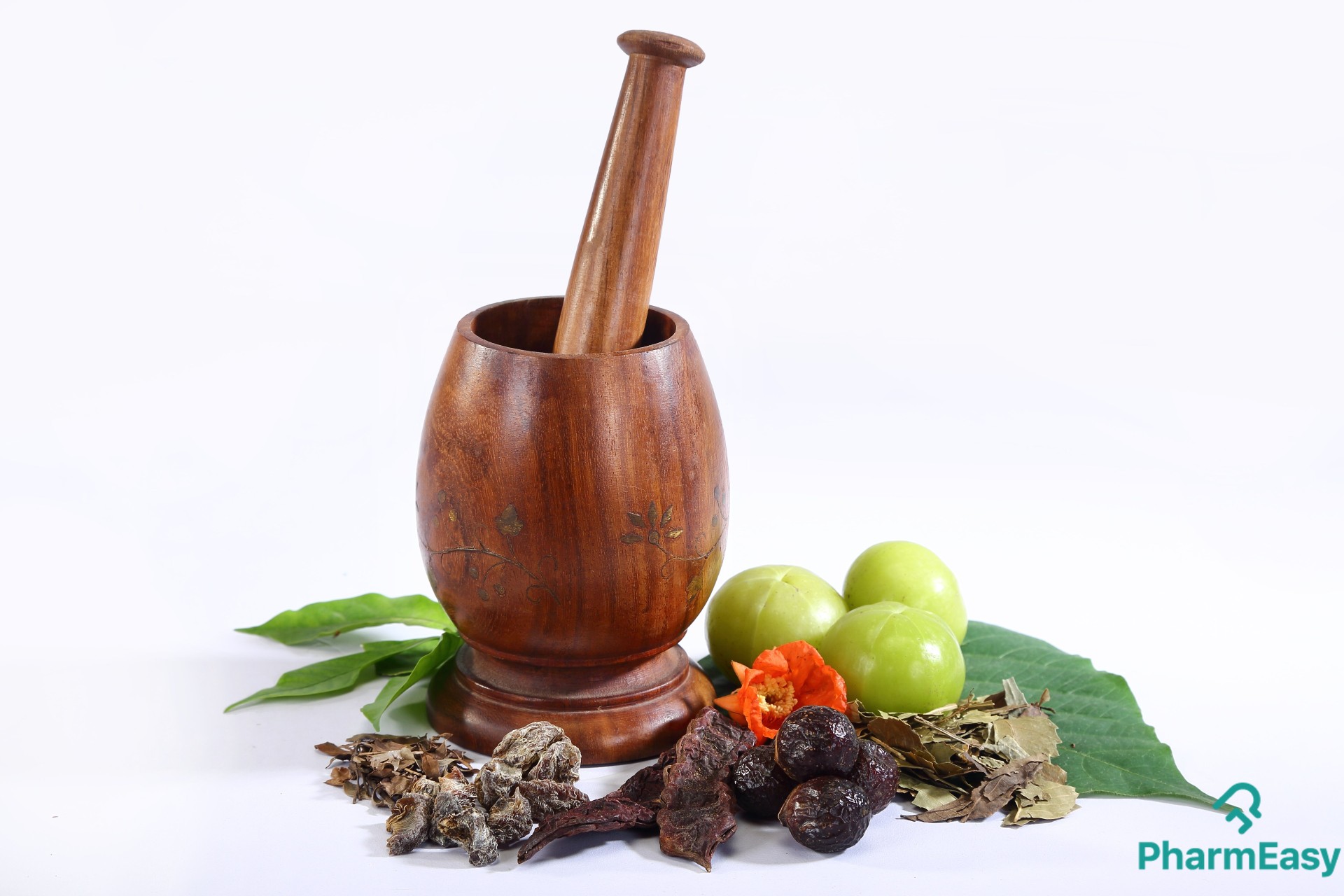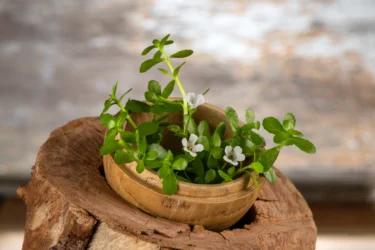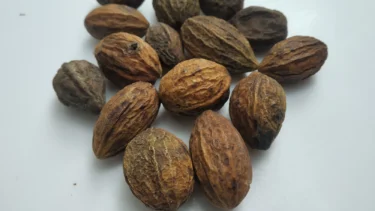8 Powerful Ayurvedic Herbs With Their Great Benefits
By Dr. Raghuveer +2 more

Get,

to manage your symptom
Get your,


4 Cr+ families
benefitted

OTP sent to 9988776655



You’ve successfully subscribed to receive
doctor-approved tips on
Whatsapp

Get ready to feel your best.

Hi There,
Download the PharmEasy App now!!


Register to Avail the Offer
Send OTPBy continuing, you agree with our Privacy Policy and Terms and Conditions

Hi There,
Sign up on PharmEasy now!!
Trusted by 4 crore+ families

OTP sent to 9988776655



You have unlocked 25% off on medicines




Code: NU25

Comments


Leave your comment here
By Dr. Raghuveer +2 more
Table of Contents
Ayurveda is an ancient Indian medical system. Ayurveda means the science or knowledge of life, where ‘Ayur’ means life and ‘Veda’ means knowledge.
The Ancient and Traditional practice of Ayurvedic is 5,000 years old and works on three basic three principles or doshas (Vata, Pitta, and Kapha) and ayurveda practice is based on three classical texts – the Charaka Samhita, the Sushruta Samhita, and the Ashtanga Hridaya which were written in Sanskrit over 2,000 years ago and are collectively known as the Great Trilogy.

Ayurveda takes a holistic approach to health, focusing on lifestyle, diet, and natural substances. It is important to note that while Ayurveda is a recognised traditional system of healthcare in India, its treatments should be approached responsibly and under the guidance of qualified practitioners. Individuals are encouraged to consult registered medical professionals for the diagnosis and management of any medical condition1.
Ayurvedic herbs are an integral part of the Ayurvedic medicine system. Since ancient times, these herbs have been used to help manage different diseases, promote mental clarity, boost immunity, and support healthy skin. In Ayurvedic practice, attention is given to the person as a whole, addressing the mind, body, and lifestyle rather than focusing solely on the symptoms of a condition. A wide range of herbs are used in Ayurveda to treat illnesses, with active ingredients derived from leaves, roots, flowers, and bark. These herbs are selected with the intention of promoting internal balance and supporting the body’s natural functions2.
Manjistha, for instance, may be beneficial in managing bone-related conditions. A 2020 study found that the root of Manjistha contains a compound that may be effective as a phytomedicine in the treatment of bone disorders16.
Dr. Siddharth Gupta, B.A.M.S, M.D (Ayu)
The Ayurvedic system offers a traditional, holistic approach to wellness, focusing on balance and overall health rather than isolated symptoms. Some of the benefits of ayurvedic herbs are as follows:
The following ayurvedic herbs have been traditionally valued for their various properties and uses over many years. Below is an overview of some commonly known herbs and their traditionally associated benefits:

Ashwagandha is a well-known herb in traditional Ayurvedic practice, used for various purposes over many centuries. The name ‘Ashwagandha’ is derived from Sanskrit, where ‘Ashva’ means horse and ‘Gandha’ means smell, suggesting, in traditional texts, the vitality and strength associated with a horse.
It is sometimes referred to as ‘Winter Cherry’ or ‘Indian Ginseng’, and is particularly noted in Ayurveda for its traditional association with supporting the body’s resilience and overall vitality. The roots of the Ashwagandha plant are commonly used in Ayurvedic preparations5. The benefits of Ashwagandha are as follows:
Ashwagandha is a versatile herb and is traditionally available in various forms, including powders, tablets, and liquid extracts. It may be taken with or without food, depending on individual preference and practitioner guidance.
Caution: The use of Ashwagandha during pregnancy is not generally recommended unless under the supervision of a qualified medical professional. Individuals with thyroid-related conditions, particularly hyperthyroidism, should seek advice from a healthcare practitioner before using Ashwagandha or related preparations.

Brahmi, also known as Bacopa monnieri, is a well-regarded herb in traditional Ayurvedic practice. It has been traditionally used for its association with supporting cognitive health and mental clarity. The plant’s leaves are considered particularly valued in Ayurvedic literature and are often used in various preparations
Brahmi is also noted in traditional sources for its natural antioxidant and soothing properties, which have contributed to its continued use over generations.
Below are some traditionally associated uses of Brahmi7:

Shatavari also known as ‘queen of herbs’. is a medicinal herb with many health benefits. The presence of saponins contributes to its antioxidant properties. Shatavari is traditionally associated with supporting immune function and female reproductive health, as described in classical Ayurvedic texts.
Here are some benefits of Shatavari8:

Liquorice has been used since ancient times in various traditional systems of medicine, including those of India, Greece, and Egypt. Owing to its naturally sweet flavour, it continues to be used in a range of preparations such as herbal teas, confectionery, capsules, and liquid extracts.
The benefits of Liquorice are as follows9,10:
Also Read: Dashmularishta: Uses, Benefits, Side Effects & More!

Neem has been mentioned extensively in classical Ayurvedic texts and is included in a large number of traditional formulations. It is often associated with supporting general hygiene, skin care, and internal balance in Ayurvedic practice11.
The benefits of neem are as follows:
Licorice root has been traditionally studied for its potential benefits in supporting oral hygiene. Some research17 suggests that compounds found in licorice may help in maintaining dental cleanliness and overall oral health. However, its use should be approached with caution and under the supervision of a qualified healthcare professional.
Dr. Rajeev Singh, BAMS

Manjistha is particularly noted for its long-standing use in Ayurvedic practices related to circulatory and skin wellness12. The benefits of Manjistha are as follows;

Amala is highly regarded in Ayurvedic tradition as a nourishing and revitalising fruit. It has naturally occurring antioxidants and helps support the body’s internal balance. The benefits of amala are as follows13:
Some studies18 suggest that Amla contains antioxidants and phytonutrients that may help support cognitive health. Its naturally high Vitamin C content is also believed to play a role in maintaining normal brain function.
Dr. Smita Barode, B.A.M.S, M.S.

Haritaki is known as the ‘king of herbs’ in Ayurveda. In traditional Ayurvedic belief, Haritaki is associated with promoting internal balance and supporting clarity of mind, vitality, and overall well-being. The benefits of Haritaki are as follows:
Also Read: Black Salt: Uses, Benefits, Side Effects, Precautions & More!
Ayurveda offers a time-tested, holistic approach to health, rooted in balance and natural practices. When used under the guidance of qualified professionals, Ayurvedic herbs may support general well-being as part of a balanced lifestyle.
Also Read: Tamarind (Imli): Uses, Benefits, Side Effects and More!
Disclaimer: The information provided here is for educational/awareness purposes only and is not intended to be a substitute for medical treatment by a healthcare professional and should not be relied upon to diagnose or treat any medical condition. The reader should consult a registered medical practitioner to determine the appropriateness of the information and before consuming any medication. PharmEasy does not provide any guarantee or warranty (express or implied) regarding the accuracy, adequacy, completeness, legality, reliability or usefulness of the information; and disclaims any liability arising thereof.
Comments

Leave your comment...

View all comments(1)
You may also like
Hi Ashish,
Most of the time a good improvement in symptoms is seen after taking vitamin B12 supplements in cases of vitamin B12 deficiency. Wish you a quick recovery and good health.